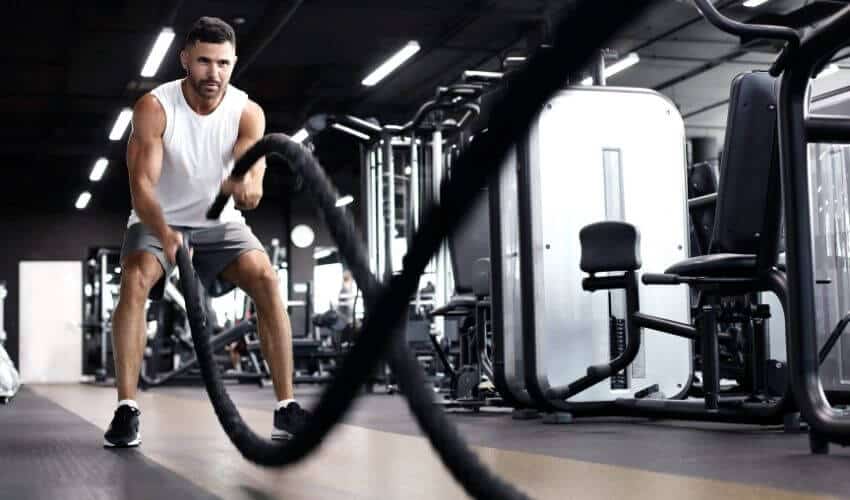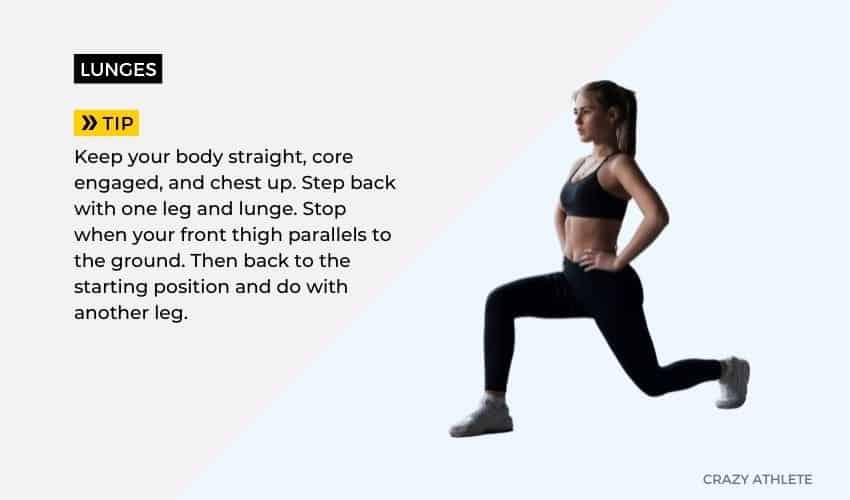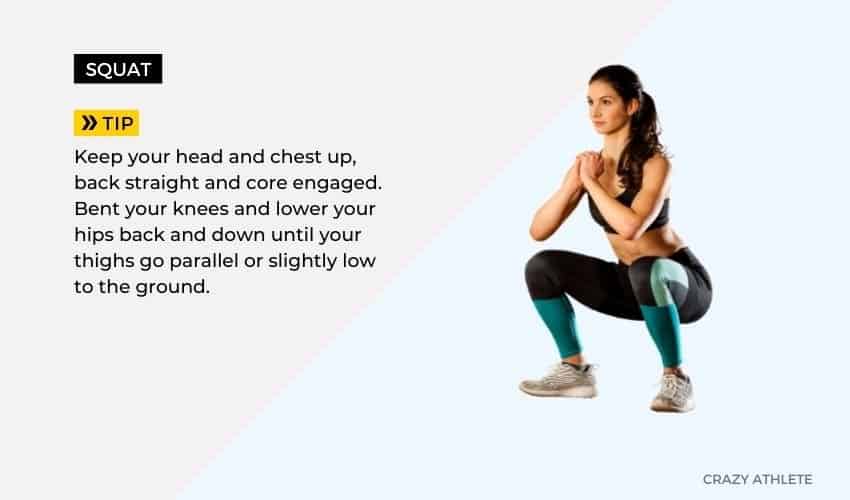Whether we’re an athlete or playing with an infant, there are plenty of reasons to want more stamina.
Low stamina levels can cause several negative effects, like limiting your workout performance and negatively affecting your personal relationships and overall health.
So, here, we’ll learn how to increase stamina naturally. And also know its benefits and seven proven ways or strategies to increase it for improving our general health and running.
What is Stamina?
Stamina is our mental and physical ability to sustain an activity for an extended period of time.
Improving stamina helps you endure discomfort or stress in a prolonged effort or training. It also allows you to perform your daily activities more efficiently and at a higher level of energy.
Benefits of Increasing Stamina
Before we get into how to increase stamina, let’s look at some crucial advantages of increasing it to make ourselves motivated to do some hard work.
Here’re the 9 key benefits of increasing stamina:
- Increase your ability to do regular activities more efficiently without getting tired.
- Improve heart and lungs health.
- Keep your muscles and bones healthy.
- Reduce the risk of injuries.
- Make your personal relationship more desirable.
- Help you maintain a healthy body weight.
- Enhance your mental health, clarity of thought, and peace of mind.
- Improve sleep quality and overall recovery.
- Boost your confidence and how you feel about yourself.
I hope we got enough reasons to work on our stamina. So, let’s get into it.
How to Increase Stamina: 7 Proven Ways

Follow these seven tips or tactics to increase your stamina.
1. Exercise Consistently
Regular exercising is the first and most important thing when it comes to increase stamina.
A long-lasting aerobic exercise or a high volume resistance training for about 45-60 minutes 3-5 days a week should be our primary goal to boost stamina.
Related: How Many Times Per Week Should I Do Cardio?
Remember, you can choose a type of exercise that you enjoy regularly doing. Otherwise, you may give up by losing motivation.
Here’re the 7 types of exercises you can perform to increase stamina:
Walk Long
Walking is often an overlooked exercise, but you should know that brisk walking can enhance your stamina and endurance level.
A study published in the British Journal of Sports Medicine found that people regularly involved in some walking activity have significant improvements in blood pressure, slowing of resting heart rate, reduction of excess body fat, reduced cholesterol, and better quality of life.
So, instead of underestimating walking, we should start doing this activity to get its benefits.
Run Hills and Stairs
I think we all know that running has significant benefits to improving our overall fitness, whether on the road, on hills, on stairs, or treadmill.
Running on the inclined surface like hills or incline treadmills can make our workout more challenging, leading to significant improvement in heart rate to burn calories fast.
If you’re not comfortable with outdoor running, you can run on the stairs at your home or use a treadmill to easily complete your daily workout and make progress towards your goal without leaving your home.
Related: The 5 Best Treadmills For Home Use in 2021
Cycling
Cycling doesn’t have to be a tour. People can get the same or even more benefits from riding a stationary bike at home.
Cycling is an easy and convenient way to exercise for an extended time, and the best part is all people can get the benefits from it with different fitness levels.
If you like outdoor cycling, just go for it because it’s a more enjoyable activity to do.
Swimming
For beginners or non-swimmers, swimming may not be the ideal option, but if you know swimming, then you should definitely try it.
It’s a very effective and easy-to-do aerobic activity that you can perform for 30-45 minutes daily to improve your stamina and overall fitness level significantly.
Aerobic Dance
Want a versatile and fun activity? Try aerobic dance. It’s a very useful activity like jogging and running, mainly for fit people.
However, if you have orthopedic problems or shortness of breath, you should not partake.
Weight Lifting
Weight lifting is an excellent way to build endurance, strength, and stamina.
Studies showed that high-volume resistance training leads to greater improvements in overall fitness. (1, 2)
The Best weight lifting exercises you should include in your routine are:
- Squats
- Bench press
- Deadlifts
- Pull-ups
- Military press
However, if you don’t have access to the gym, you can do some bodyweight movements, like pushups, squats, burpees, jump rope, jumping jacks, etc.
Related: 30 Best Bodyweight Workouts You Can Do at Home
If you’re just starting your gym workout, read the article that covered a three-month perfect beginner workout plan in a step-by-step fashion to kickstart your gym workout.
Sports
If you like to play sports like football, badminton, cricket, or whatever, just go for it. It helps to improve your fitness, clarity of thought, and of course, your desired stamina level.
It’s one of the easiest ways to stay physically active and motivated in the long term because it’s something you already love doing.
So, enjoy your game and increase stamina without putting in the extra effort.
Note: First, you should focus on duration instead of intensity when it comes to building stamina. Then gradually increase the time and then intensity according to your physical capacity.
2. Eat Balanced Diet
When working hard to build stamina, it’s important to give your body the right nutrients for proper recovery and growth.
When we talk about improving stamina or overall fitness, we need to consume a combination of carbs, protein, and fats.
When you consume carbs, it converts into glucose and is stored in the glycogen as energy. So, for a prolonged intensive workout, taking enough carbs is crucial.
However, a good amount of protein and fat is also important to maintain muscle mass and perform long-duration workouts.
Here’re the foods sources you can include in your diet:
- Carbs: Oats, brown rice, brown bread, sweet potato, millet, quinoa, wheat pasta, beans, etc.
- Protein: Chicken, fish, eggs, mutton, milk, yogurt, greek yogurt, paneer, soy, whey, etc.
- Fats: Peanuts, cashews, almonds, walnuts, seeds, whole egg, salmon fish, olive oil, etc.
Sample meal timing: One cup of oatmeal in the breakfast, take nuts and fruits as a snack (mid-morning and evening), and beans in the lunch to perform an intensive workout in the evening.
If you exercise in the morning, have oatmeal around 60-90 minutes before the workout to get a high-performance session.
Related:
- 10 Best Foods to Eat Before a Tough Workout
- The 20 Best Foods to Eat After an Intense Workout
- 10 Delicious Muscle Building Breakfast Ideas
3. Take Caffeine Before Workout
If you want to boost your workout stamina and performance, caffeine is a critical ingredient you can take before a workout.
It helps you to increase your focus, concentration, and stamina to exercise for an extended period. Also, caffeine may give you a boost on the days when you’re tired or feeling low.
You can take one cup of black coffee or caffeine supplement 15-30 minutes before a workout to boost your performance.
However, you shouldn’t rely too much on caffeine since you can build up a tolerance, or you may no longer experience its energy-boosting effects.
So, it would be a good idea to take caffeine on the days you need the extra push to hit tough workouts, and it should be a maximum of 2-3 days a week.
Related: How Long Does Pre-Workout Supplement Last?
4. Avoid Foods that Kills Stamina
When you’re consistently workout and taking the right diet, it’s also important to STOP consuming some foods that limit your progress and even kill your stamina level.
The foods you should avoid to build stamina are:
Alcohol
Alcohol is a strict NO, especially when you’re looking to increase stamina and improve your fitness and overall well-being.
Alcohol makes our body movement slow which leads to dehydration during post alcohol or even the next day.
So, if you’re going to the gym or preparing for a stamina base competition like a marathon, make sure you avoid consuming alcohol.
Fried foods:
Craving for fried foods is evident as they are crispy and so tasty. However, you have to break your fast food consumption if you really want to increase your stamina.
Fried foods tend to take too long to break down in the stomach as they are high in unhealthy fats.
You should avoid these foods, especially right before your workout, as they take a long time to move through the digestive system and decrease your performance.
Too much consumption of fried foods can make you feel lethargic, which may demotivate you to exercise that day.
So, try hard to maximize the time between your two cheat meals. It should be no more than once a week.
Dairy products:
Before going to the gym, you should also avoid dairy products like milk and yogurt.
Its sugars are slow-digesting take longer to digest and may upset the stomach. It also leaves a coating in your mouth, which feels unpleasant during exercise.
Although milk and yogurt are excellent foods for muscle recovery, they provide an outstanding balance of carbohydrates, protein, and fats.
So, passing them in pre-workout and having them at other times of the day is perfect.
You should also avoid foods like soft drinks, pasta, fried or high fatty foods, especially in the pre-workout meal, as they can ruin your performance and endurance.
Related: 16 Foods You Should Avoid Before (and After) a Workout
5. Listen to Music While Exercising
Listening to music can significantly increase your workout efficiency and concentration.
A 2016 study proved that listening to preferential music could effectively increase endurance and stamina during a workout.
So, don’t forget to wear your earphones during a calorie-torching workout.
6. Stay Hydrated
Staying hydrated is one of the crucial factors to keep your body energetic for a long-lasting activity.
Most of us aren’t drinking an adequate amount of water per day which causes dehydration, leading to many negative effects on the urinary tract, balancing metabolism, and important body functions.
So, it would be best to drink some ounces of water during a workout and about 3-4 liters throughout the day to increase and maintain your stamina and overall health.
7. Take Adequate Rest
While consistently exercising is important, it’s also crucial to take your body adequate time to rest for recovering broken down muscle tissues.
And we all know that the growth of our body isn’t done when we work out but while we sleep.
So, our aim should be to take at least 7 hours of quality sleep every night to get the best possible results of all the hard work we’re doing by working out and taking good meals throughout the day.
Bonus #1. Mind Game
Using our mind’s power is one of the critical and smart ways to increase stamina.
“Our minds are the key to either pushing our bodies or stopping short,” says Giovinazzo.
All you need to do is imagine in the night before you sleep and first in the morning that you’re following the above ways consistently. Day by day, the graph of your stamina and performance levels is going significantly upward. And, within a few weeks, you’ll notice the magic.
How to Increase Stamina for Running?
As we already know, stamina is the ability to sustain prolonged physical and mental effort or, more simply, push yourself past a point you couldn’t get there before.
Running isn’t the only thing to build running stamina.
There’re several ways and workouts you can perform to boost your running stamina, such as:
1. Walking Lunge

Lunge might be looked at as a strength movement, but here we will use it for multiple repetitions to get you breathing heavy, which will help you build that endurance to run longer.
Also, it will help build your lower body stronger, enhance your running form, and learn how to keep going in a long workout session.
We’ll do 3-sets of 3 minutes walking lunges. The pace is your choice, but your aim should be to keep moving the entire time. And we’ll take 2-minute rest between sets.
How to do walking lunges:
- Start with your feet about hip-width apart.
- Keep your head and chest up, back straight, core tight, and hips squeezed.
- Kick your front leg out to the front and lower the back knee down to kiss the ground.
- Make sure your knees don’t go over the toe and keep it straight verticle.
- Put the pressure on the front heel and stand up straight.
- Perform that movement for the whole three minutes, rest for two, and repeat that twice more.
2. Keep Moving for 20 Minutes
“Something feels hard because you’ve done something easier, and something feels easier because you’ve done something harder than it before” — we’re going to follow that in this workout.
Although this is more focused on gearing beginner athletes, but of course, anyone can apply this to consolidate their foundation of running.
You can adjust the workout that fits you and get you to keep moving through the hard parts rather than just stop every time it feels difficult.
So, all you need to do is set a 20-minute clock and start exercising.
There’re a couple of different versions of this workout you can do, such as:
- Climbing stairs: This is the hardest thing you can do during this workout. You could just be walking or jogging up the stairs.
- Jogging: If climbing stairs feels too hard for you, you can go for a jog on a flat surface instead of stopping.
- Walking: If jogging feels hard, you can take it to walk.
Remember, our aim in this workout is never to stop during the 20 minutes workout.
You can switch the gears to the easier versions to take some breath and then go to the next level again.
So, we’re going to challenge ourselves to work in between those movements without stopping altogether.
As we get stronger to build that endurance, we will sustain the harder levels for longer to get our stamina to pick up.
3. Include Recovery
A good stamina indicator is being able to work more on less rest.
So, our third workout is to focus on our recovery time and decrease that recovery without compromising our efforts.
Instructions:
- 5-set of 400 meters or a quarter-mile run.
- Then rest time between rounds: 2:30 min, 2 min, 1:30 min, and 1 min respectively between rounds.
Here, we aim to go for 7-8/10 perceived effort. This means we’re not in for the all-out sprint, which would consider 10/10, and obviously not walking at that 1/10.
So, you should find a pretty hard effort and push yourself a little more so that your body actually needs those recovery periods between sets.
Then what we gonna do is decrease the rest by 30 seconds each time.
For example, if we start it with a 2:30 minute rest, bring it down to 2-minute rest to the next set, then 1:30 minute, etc.
But you should challenge yourself by holding the SAME PACE for each run.
So, in this workout, you’re pushing hard, and at the same time, you’re really focused on taking recovery periods.
4. Nose Breathing Drill (Pro Tip)
I think you may notice that when we are running, our breathing becomes a problem. And it’s because you may probably not be sure how to make full use of dip breathing to calm down your running.
I mean, there’s a way or technique to dial in deep belly breathing that will help your running calmer, smoother, and longer.
How to do nose breathing drills?
- Put both hands on your belly, close your mouth, and take a deep/big inhale through your nose.
- Feel the air fill up the stomach and then exhale either through your nose or through your mouth.
- Perform that during your walk/run every 5 minutes for 1 minute.
Within a couple of deep breathing during your fast walk or workout, you’ll feel your mind calm and make your workout a lot more comfortable and easier.
5. Combining The Workouts
Here, you’ll do a combination of four exercises to increase your stamina and athletic performance and make your running more exciting and fun.
We’ll combine a short run and a little bit of walk with some squats and a plank.
The workout sequence is as follows:
- 400 Meter run (a quarter-mile)
- A little walk (if needed)
- Squats
- Plank
First, we’ll do a 400-meter run with a little bit of walking, and then we’ll do 10-15 squats and finish with a 30 seconds plank.
How to do squats?

- Stand with your feet hip-width apart.
- Keep your chest up, back straight, and butt nice and tight.
- Then take a nice deep breath, and as you go down, slightly bend your knees forward and hips down and back.
- Go down like you’re just touching the chair with your hips and then stand back up.
- Repeat that up and down movement for 10-15 repetitions.
Right after squats, we’ll do a plank for 30 seconds.
How to do a plank?

- Place your elbows and toes on the floor, and keep your body in a straight line (head to heels).
- Keep your legs together, butt squeezed.
- Squeeze your core and hold them for 30 seconds.
- You can practice a couple of deep nose breaths in this plan position.
Okay, now we’ve finished the first round of this combination workout. Now take 2-minute rest and then do the next round.
You should perform about 3-5 rounds of this workout. You can increase the rounds if you feel you can able to do more.
What are the benefits of this combination workout?
This combination workout will help you in a few things, such as:
- You’ll get stronger.
- Squats help you improve your running form and strengthen your quads, butt, glutes, and hamstrings.
- Plank helps you get a strong core which is great for everything.
- And you can practice running at a speed that feels good to you and makes your running more exciting and fun.
- Regularly performing this combination workout can significantly improve your running stamina and endurance level.
Conclusion
Okay, now you’ve got the formula for increasing stamina for your general health or any specific sports like running.
Remember, building stamina and endurance is a natural process, and it takes time to increase.
So, it would be best to stay focused on your ideal plan to improve your overall health and well-being.
Have any questions regarding stamina and endurance?
Feel free to ask in the comment section below. I will be glad to help you!
Read Next: Endurance vs Stamina: Differences and Tips to Increase Both


